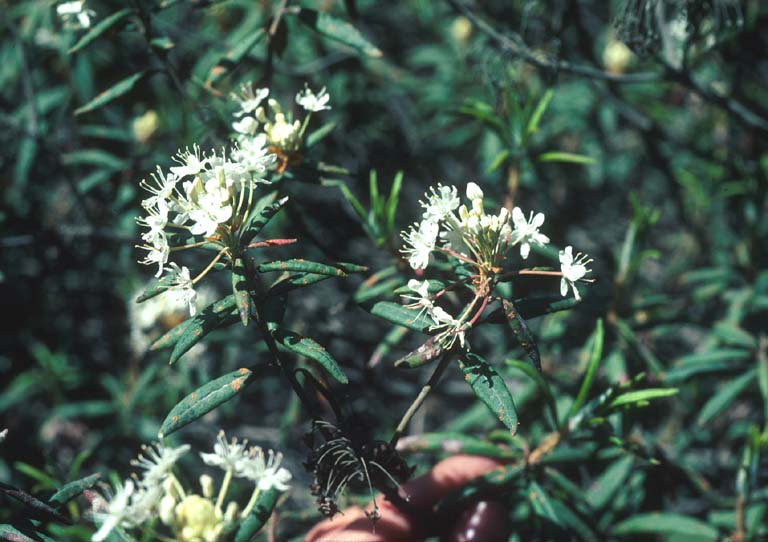Plant Data Sheet
Species:
Labrador tea, Ledum groenlandicum

photo
credit: UW Library Digital Collection, Plants of Western Washington Collection
http://content.lib.washington.edu/pww/plants-copyright.html
Range:
Alaska
to Oregon in the western United States, east across Canada and Greenland,
northern great
lake states,
and New England
(Coladonato, 1993)
Climate, elevation:
Tundra
and boreal climates, low elevation to mid elevation in Cascade mountains,
higher elevation in Northern Rockies (Coladonato,
1993)
Local occurrence:
Somewhat
uncommon due to reduction of habitat.
Habitat preferences:
Sphagnum
bogs, muskegs and tundra, with low nutrients and low flow of subsurface water.
Can tolerate range from wet to dry. Can
tolerate some shade.
(Coladonato,
1993)
Also
in forested or shrub swamps, but generally intolerant of shade (Cooke,
1997)
Wet, stable, interdunal wetlands on the coast of Oregon (Franklin
and Dyrness, 1988)
Wet
to very wet soil, low in nitrogen, shade
intolerant (Klinka
et al, 1995)
Plant strategy type/successional stage:
Stress
tolerator. Seral species in woodland understory, dominant species in open
bogs (Coladonato,
1993)
Reported
to naturally recolonize disturbed powerline corridors in boreal bogs
(Coladonato,
1993),
and was recommended for use in reclamation of following peat-mining projects
(Famous and Spencer, 1989).
Associated species:
Kalmia
microphylla , Vaccinium oxycoccus, Sphagnum spp.,
Cladonia
sp. (Coladonato,
1993)
Thuja
plicata, Pinus contorta (Franklin and Dyrness, 1988)
May
be collected as:
Seed
(Schultz
et al, 2001)
naturally
reproduces from rhizomes or seed (Coladonato,
1993)
Collection restrictions or
guidelines:
Flowers
May through June, fruits ripen August through fall
(Coladonato,
1993)
Seed
is an elliptical capsule (Schultz
et al, 2001)
Seed germination:
not
found
Seed life:
store
up to 3 years (Schultz
et al, 2001)
Recommended seed storage conditions:
Cool
dry, refrigerator or cool garage (Schultz
et al, 2001)
Propagation recommendations:
The following
protocol for cuttings is from, Schultz
et al, (2001) working
in Michigan:
Macerate by hand with sieve to remove pulp immediately after
collection, and separate pulp from seed by floating pulp
Dry seeds for one week
Sow into plug trays with the following cell dimensions: 2"
diameter by 4" depth
Plug trays are filled with moistened and firmed media (see
below)
Sow one seed per cell, cover with thin layer of soil
Sown at all times of year due to unpredictable germination
Watered using mist, no additional light, no fertilizers
Greenhouse conditions set for 65° F day and night January
through August, summer highs may reach 100° F
September through December greenhouse set to 55°F but
may reach 75°F
Plants are hardened off in outdoor cold frame, reduce water,
and protect from frost and sun-scorching
Soil or medium
requirements:
Scotts Redi-earth Plug
and Seedling mix (vermiculite/sphagnum peat moss) (Schultz
et al, 2001)
Installation form:
Plugs
(Schultz
et al, 2001)
Recommended planting density:
not
found
Care requirements after installed:
install into acid bogs, conifer swamps, moist conifer woods
and peaty soil (Schultz
et al, 2001)
Normal
rate of growth or spread; lifespan:
Slow,
long-lived
Sources cited:
Coladonato,
Milo. 1993. Ledum groenlandicum. In: U.S. Department of Agriculture, Forest
Service, Rocky Mountain Research Station, Fire Sciences Laboratory (2003,
May). Fire Effects Information System, [Online]. Available: http://www.fs.fed.us/database/feis/
[accessed
May 12, 2003].
Cooke,
Sarah Spear. 1997 A Field Guide to the Common Wetland Plants of Western Washington
& Northwestern Oregon. Seattle Audubon Society, Seattle, WA 415 p.
Famous,
Norman C.; Spencer, M. 1989. Revegetation patterns in mined peatlands in central
and eastern North America studied. Restoration and Management Notes. 7(2):
95-96.
Franklin,
Jerry and C.T. Dyrness. 1988 Natural Vegetation of Oregon and Washington.
Oregon State University Press, Corvalis, OR 452 p.
Klinka,
K., V.J Krajina, A. Ceska, and A.M Scagel. 1995 Indicator Plants of Coastal
British Columbia. UBC Press
Vancouver B.C. 288p
Schultz,
Jan; Beyer, Patty; Williams, Julie. 2001. Propagation protocol for production
of container Ledum groenlandicum Oeder plants; Hiawatha National Forest, Marquette,
Michigan. In: Native Plant Network. URL: http://www.nativeplantnetwork.org
(accessed 14 May 2003). Moscow (ID): University of Idaho, College of Natural
Resources, Forest Research Nursery.
Data
compiled by:
Matthew
Ramsay, May 12, 2003
